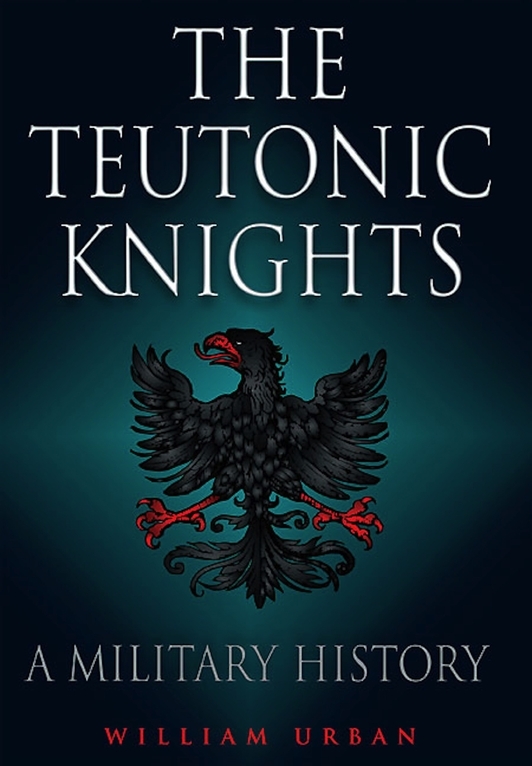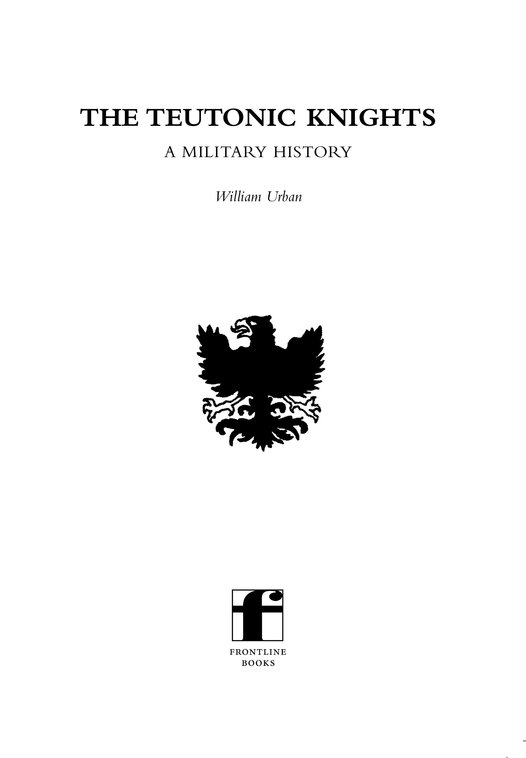Teutonic Knights
Authors: William Urban
Tags: #History, #Non-Fiction, #Medieval, #Germany, #Baltic States



A Greenhill Book

First published in Great Britain in 2003 by
Greenhill Books, Lionel Leventhal Limited
www.greenhillbooks.com
Reprinted in this format in 2011 by
Frontline Books

Pen & Sword Books Ltd
47 Church Street
Barnsley
South Yorkshire
S70 2AS
© William Urban, 2003
9781783031009
The right of William Urban to be identified as
author of this work has been asserted by him in accordance
with the Copyright, Designs and Patents Act 1988
A CIP catalogue record for this book is
available from the British Library
All rights reserved. No part of this book may be reproduced or
transmitted in any form or by any means, electronic or mechanical
including photocopying, recording or by any information storage and
retrieval system, without permission from the Publisher in writing.
Printed and bound in England
by CPI
For a complete list of Pen & Sword titles please contact
PEN & SWORD BOOKS LIMITED
47 Church Street, Barnsley, South Yorkshire, S70 2AS, England
E-mail: [email protected]
Website:
www.pen-and-sword.co.uk
Copyright Page
List of Illustrations
Preface
Introduction
1
-
The Military Orders
2
-
The Foundation of the Teutonic Order
3
-
War in the Holy Land
4
-
The Transylvanian Experiment
5
-
The War against Paganism in Prussia
6
-
The Crusade in Livonia
7
-
Territorial Rivalries with Poland
8
-
The Lithuanian Challenge
9
-
The Conversion of Lithuania
10
-
The Battle of Tannenberg
11
-
The Long Decline and the End in the Baltic
12
-
The End in Livonia
13
-
Summary
Appendices
Bibliography
Index
- A grave marker at Holm. David Nicolle, National Latvian Museum, Riga
- Charging German knights. Ian Peirce, Cathedral Treasury, Aachen
- A manuscript illustration of crusaders in combat.
- Jousting knights. David Nicolle, Malbork Castle Museum
- Knights in combat. Malbork Castle Museum MZM/DA/5
- Knights in combat. David Nicolle
- Knights jousting, victory going to the rider with the griffon coat of arms.
- The ruins of Doblen. Bildarchiv Foto Marburg 152 632
- The ruins of Wenden. Bildarchiv Foto Marburg 153 194
- Marienburg castle from the Nogat River. William Urban
- Marienburg castle from the southeast.
- Marienburg castle walls and warehouse façade. William Urban
- The great hall in Marienburg Castle. Bildarchiv Foto Marburg 619 159
- Marienburg castle’s middle courtyard. William Urban
- Jan Matejko’s sketch for his large scale painting of the Battle of Tannenburg (1878). Warsaw National Museum
- Werner Peiner: The Siege of Marienburg (1939)
- The ruins of the castle at Wenden. Bildarchiv Foto Marburg 183 202
- Banners hanging in Marienburg castle. William Urban
Endpapers: Crusaders in combat against eastern warriors.
My previous publications in Baltic history
1
have been of four kinds: translations with Jerry C. Smith of important chronicles; articles attempting to correct factual errors or present new interpretations of events in the crusades in Prussia and Livonia; summaries of the crusades for various encyclopaedias; and five detailed histories of individual crusading eras – the thirteenth centuries in Prussia and Livonia, the later crusades in those regions, and the decisive events connected with the battle at Tannenberg and its aftermath. This volume is, therefore, the culmination of almost forty years of research and writing. It is the first survey of the military history of the Teutonic Order in English and the first lengthy one in any language in almost a century.
There are many people that any author can reasonably thank for contributing to his or her work. I am no different. At the beginning was Archie Lewis, who persuaded me to work on a subject that few in the United States knew much about at the time – the Baltic frontier between Roman Catholicism, Russian Orthodoxy and paganism. The German-American Clubs and the Fulbright Commission financed a year in Hamburg, when I learned something about the subject and began to write. Several years later the Fulbright Commission gave me a grant to work at the Herder Institut in Marburg, a marvellous location for research that I subsequently visited many times. And so it went, right down to the publisher of my most recent books, John Rackauskas and the Lithuanian Research and Studies Center in Chicago. All along the way I have met interesting and helpful people, visited places I will never forget, and made life-long friends.
William Urban, 2003

Why a book on the military history of the Teutonic Knights now? Why not earlier? Good questions, and questions worth considering. One answer is that the best historians of the crusades have traditionally concentrated their attentions on the Holy Land; most medieval historians in recent decades have lacked much interest in military affairs; and amateur historians in the English-speaking world are not prepared to handle the many languages involved in studying Baltic and East Central European history. In addition, the Cold War made research in those regions difficult and, too often, also made people wonder if military history specialists were not politically suspect. Another good answer, perhaps more fundamental, is that the English-speaking public was generally unaware that there had been crusades in the Baltic, and, moreover, for many years also lost interest in the medieval efforts to recover Jerusalem. No demand, hence no response by authors and publishers.
However, public taste changes. Today books on the crusades are popular once again. Moreover, there is an interest in crusading activities on the periphery of Europe. Just as Chaucer’s knight understood that there were crusading efforts in Spain, Prussia, Asia Minor and the Balkans equal to those in the Holy Land, or almost so, now modern scholars and the general public recognise this as well.
Nor does the Baltic seem as physically distant as it was only a few years ago. Tourists can now easily visit towns and castles built by the Teutonic Knights. Castle ruins are romantic, and ruins abound in what were once Prussia and Livonia. Poland has taken the lead in developing this theme: Malbork (Marienburg) is already a tourist centre, as is the battlefield of Grunwald (Tannenberg), with its disputed positioning of the opposing armies; and the historic centres of ancient towns such as Gdańsk (Danzig) have been restored. Latvia has Riga, Estonia the old city of Tallinn (Reval), completely surrounded by the original walls and towers, and Lithuania has the beautiful island castle at Trakai. People who have seen Eisenstein’s inaccurate but thrilling movie
Alexander Nevsky
can visit the shores of the lake where the real battle was fought, on its frozen surface, on 5 April 1242.
There are two sites in Central Europe which are also worth seeing – Bad Mergentheim in Germany, north-east of Stuttgart, which was the seat of the grand master of the Teutonic Order after the secularisation of the Prussian lands; and Vienna, where the modern headquarters sit one block from St Stephan’s cathedral. Both have attractive museums. There are also the order’s many surviving convents, churches and castles in Germany, Austria, the Czech Republic and even Italy.
There is much history to be learned here, or perhaps re-learned: the Teutonic Knights were once powerful and respected in Central Europe, but their reputation has suffered in medieval and modern times at the hands of propagandists, nationalists, Protestants and secularists. This drumbeat of condemnation was, of course, to some degree earned, but was exaggerated by the accompanying suggestions that their enemies were pure in heart, mind, and action. These perceptions are now being rethought.
Similarly, our understanding of Europe is being revised in countless ways. The frontiers of medieval Christendom are remarkably similar to those of the modern European Union, and wars on the periphery represent challenges for modern statesmen. Chamberlain could abandon Czechoslovakia to Hitler as a place far distant, about which Englishmen knew little; but today newspaper readers in the English-speaking world can talk knowledgeably about European conflicts much farther away and more difficult to understand. Even so, those of us who experienced the difficulties of travelling in East Central Europe before 1989, and who try to describe our experiences to students and younger colleagues, already encounter faces as uncomprehending as when we attempt to explain the complexities of medieval life and politics.
Hitler, by the way, mistrusted Roman Catholics and hated nobles, so he had nothing good to say about the Teutonic Order. As a lower-class Austrian he disliked the Prussian Junkers too (who, in any case, mostly came from Brandenburg, not East Prussia, were almost all Protestants, and only very rarely had ancestors who were members of the military order). So for understanding the military history of the Teutonic Order, it is best for us to drop the Hollywood stereotypes until the next Indiana Jones fantasy comes along. The true stories about the Teutonic Knights are sufficiently interesting (exciting, controversial, etc) that we do not have to distort them, and modern politics already contain sufficient misleading stereotypes without digging back into medieval history for more.
It is my hope that this volume will further our understanding of a very important era in military history, of the complexities of medieval politics, to a certain extent of human behaviour in general, and of the ways that modern societies think about their past. I find narrative history relaxing, especially when it is removed from the constraints of nationalism and politics. So settle back, and take a moment to enjoy an armchair time-travel back to the Middle Ages, back to a time when men and women were neither better nor worse, perhaps, than today, just somewhat different.